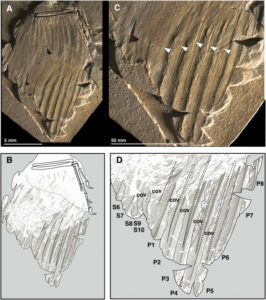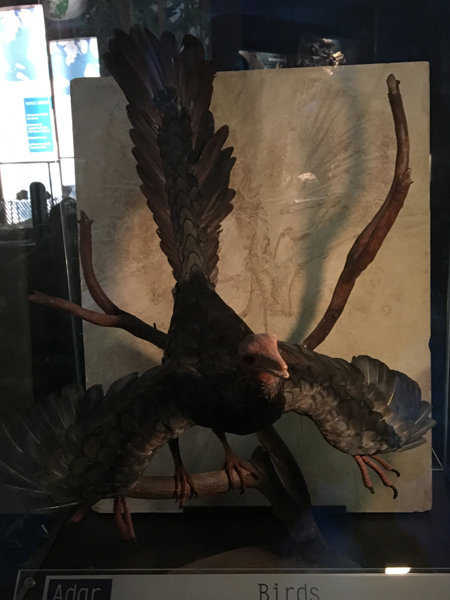In a Flap over Dinosaurs, Feathers and Flight
Archaeopteryx – Mainly a Glider say Research Team
A team of international researchers, scientists from the University of Bristol, the United States and the Beijing Museum of Natural History (China), have concluded that Archaeopteryx (A. lithographica) was more of a glider than a flapping flier, able to take-off from the ground. An analysis of the structure and composition of the wings of this Late Jurassic animal suggests that the wings although covered in feathers, were very different when compared to the modern wing of an extant bird, a member of the Neornithes.
Archaeopteryx
This new research, published in the academic journal “Current Biology”, proposes that the earliest forms of creature, evolving towards the Aves (birds) had layers of rigid feathers on their wings that made up an aerofoil surface which provided lift. In the past, palaeontologists had assumed that the composition of the wing of Archaeopteryx was the same as modern birds, that wings were essentially modified forelimbs that were covered in a single layer of long, asymmetrical flight feathers with shorter, covert feathers on top. Modern birds are able to use their wings to obtain lift, thrust and to manoeuvre by separating their feathers and rotating them. This new study suggests that primitive, transitional birds such as Archaeopteryx may have been effective gliders, rather than creatures capable of true, powered flight.
Archaeopteryx fossils must be some of the most closely studied objects known to science. Recently, there have been a number of exciting, scientific papers published about this enigmatic creature, for example, palaeontologists have been able to work out what this animal may actually have looked like.
To read an article about the colour of Archaeopteryx: sets: Archaeopteryx – The World’s Oldest Black Bird?
Named and Described in 1861
The crow-sized Archaeopteryx was named and described by the German palaeontologist Hermann von Meyer in 1861. The first fossil evidence of Archaeopteryx that came to the attention of science was a single, fossilised feather that was found in 1860. A second fossil showing much of the skeleton and the fossilised impressions of feathers around the wings and tail was uncovered in 1861. This specimen was purchased by Sir Richard Owen (the founder of the Natural History Museum in London); he paid £700 for it – a huge sum of money in those days. This fossil has become known as the London specimen. In total only a handful of Archaeopteryx fossils have been found (seven specimens and one fossil feather). The first Archaeopteryx fossil was found in 1855, but at the time it was wrongly classified as a pterodactyl (flying reptile), it was finally classified as a fossil of Archaeopteryx in 1970. In 1859, Darwin published his theory of evolution “The Origin of Species”, he argued that species gradually evolved and changed in response to their environments and other factors and that this led to new speciation. The discovery of a feathered creature with wings like a bird but teeth and a tail like a reptile, was taken as evidence to support Darwin’s theory of natural selection.
Fossils of Archaeopteryx Provide Vital Clues to the Evolution of Powered Flight in Vertebrates
Picture credit: Longrich et al Current Biology.
Studying Archaeopteryx Specimens
The research team studied a number of Archaeopteryx specimens, including the famous “Berlin” specimen. These fossils were compared and contrasted with the remains of a feathered, ground-dwelling, cursorial dinosaur known as Anchiornis (A. huxleyi). Anchiornis was a crow-sized dinosaur that lived in north-eastern China approximately 160 million years ago, a few million years before Archaeopteryx evolved. A number of specimens are known, all of which have come from the famous Liaoning Province of China. This little reptile was covered in feathers. It had long feathers on its arms and legs making a sort of fore and hind wing arrangement similar to that seen in another Chinese dinosaur Microraptor (Microraptor gui). The research team conclude that feathers first evolved for insulation, thus supporting the theory that many dinosaurs were warm-blooded (endothermic). Some feathers became display structures for courtship and other purposes and only later, around 130 million years ago did the modern wing structure evolve.
An Illustration of Archaeopteryx (Museum Exhibit)
Picture credit: Everything Dinosaur
To view replicas of Archaeopteryx and other types of theropod dinosaur: PNSO Dinosaur and Theropod Models.
The wing function of Archaeopteryx may represent a transition from a cursorial lifestyle to that of a modern flying bird, the layers of feathers being a sort of early evolutionary experiment in wing design. Although the individual feathers of Archaeopteryx may have been quite weak (indicated by the thin rachis (feather shaft)), the layered effect of the wing would have provided a relatively efficient aerofoil structure for the animal to use when gliding from tree to tree. Not being able to separate feathers as birds can do today, would have limited Archaeopteryx’s flying skills. Taking off from the ground and flapping vigorously at low speeds may have proved very difficult for this little creature.
Dr Jakob Vinther, of the University of Bristol (School of Biological and Earth Sciences), commented:
“We are starting to get an intricate picture of how feathers and birds evolved from within the dinosaurs. We now seem to see that feathers evolved initially for insulation. Later in evolution, more complex vaned or pinnate feathers evolved for display.
“These display feathers turned out to be excellent membranes that could have been utilised for aerial locomotion, which only very late in bird evolution became what we consider flapping flight. This new research is shedding light not just on how birds came to fly, but more specifically on how feathers came to be the way they are today – one of the most amazing and highly specialised structures in nature.”
Early Birds
One of the authors of the research paper, Dr Nicholas Longrich of Yale University added that as a result of carefully studying these Middle and Upper Jurassic fossils, scientists are able to conclude that early birds had more primitive wings than their modern counterparts. Over the next thirty million years or so, the wing structure gradually evolved and become a more efficient organ of flight. The wings of birds from sediments deposited 130 million years ago are essentially identical to those of modern, extant Aves.
To read an article about the discovery of Anchiornis: Is Archaeopteryx about to be Knocked off its Perch?
Although, the wings of early, transitional creatures such as Archaeopteryx may have lacked the range of functions seen in Neornithes today, it is interesting to note that there is one type of bird today that has a similar, layered structure of feathers on its wing – the Penguin. Penguins, originally descended from birds that could fly, but they have lost their ability to take to the air, and the layers of feathers are used to insulate their bodies from the cold. Thus the feathers found on extant Penguins perform a very similar function to those seen on the Middle Jurassic dinosaur Anchiornis, they are primarily used for insulation.
Everything Dinosaur acknowledges the assistance of a media release from the University of Bristol in the compilation of this article.
The scientific paper: “Primitive Wing Feather Arrangement in Archaeopteryx lithographica and Anchiornis huxleyi” by Nicholas R. Longrich, Jakob Vinther, Qingjin Meng, Quangguo Li and Anthony P. Russell published in Current Biology.



